What's it Wednesdays: The Boston Post Cane
The story of the Boston Post Cane is a lost-and-found story
Welcome or welcome back to History Buzz! If you’re a subscriber to the Buzz, thank you! If you’re new here, or you haven’t become a subscriber yet, please sign up for a subscription to have History Buzz delivered directly to your inbox.
Andover, like 700 towns throughout New England, was the recipient of a “Boston Post Cane” in August of 1909. The cane was intended to be “transmitted” to the oldest man in town. The canes were made by the J.G. Fradley company in New York. Lengths of ebony wood from Africa were cut to cane length, seasoned for six months, and turned on lathes. The tip of the cane was covered with a ferrule, and the head was 14-carat gold inscribed with the following,
Presented by the Boston Post to the oldest citizen of (name of the town) To be transmitted
But how did the canes come to be?
In August 1909, Edwin A. Grozier, the publisher of the Boston Post newspaper, had the canes created and sent to the Board of Selectmen in 700 towns in New England. The canes were to be managed by the local Board of Selectmen, who were to be the trustees of the canes. They were to ensure that the cane was always in the hands of the oldest male resident of town.
In 1924, Edwin Grozier died and his son, Richard, took over the newspaper. Richard, however, was not able to achieve the same level of success as his father and later died in a psychiatric hospital. At one time one of the country’s leading newspapers, the Post went into decline and closed in 1957.1
Andover’s Boston Post Cane
The Andover Townsman newspaper reported on the whereabouts and holder of the town’s Boston Post cane for 43 years, from 1909 until 1952, about five years before the Boston Post ceased production. The first mention was in August 1909 when the first recipient of Andover’s cane was announced. Mr. A.P. Cheney held the cane from 1909 to 1911.
A.P. Cheney Receives Handsome Walking Stick
The ebony, gold-headed cane . . . has been given by the selectmen to A.P. Cheney of 87 Water Street. Chairman, Peter Holt, tendered the gift in a most appropriate speech at the venerable gentleman’s home the other evening. Mr. Cheney is now in his 91st year, having been born September 27, 1818. The conditions of the award call for the cane to be presented to the oldest male resident, and at his death, to be handed down to the next oldest.2
A record in the files of the History Center lists Benjamin Wardwell as the holder of the cane between April 1911 and November 1912. In August 1913, the Townsman reported that the selectmen presented the cane to Timothy Abbot.
A few years ago, the Boston Post presented a gold-headed, ebony cane to the oldest man in many of the suburban towns of Boston. The Andover cane was . . . given to Benjamin F. Wardwell who passed from earth a few months ago at the great age of ninety-six years. This past week the cane was brought by the selectmen to Timothy Abbot who passed his ninetieth milestone on Wednesday of this week.3
But Timothy Abbot does not appear on the record of Andover’s Boston Post cane, likely because he held it for just three months. Timothy Abbot died in December 1913, three months after the cane was presented to him.
At the end of 1913, Sleigh Rowland became the next man to hold Andover’s cane. Mr. Rowland held the cane until his death in December 1916.
In September 1916, the Townsman reported that Mr. Sleigh Rowland had celebrated his 93rd birthday “by entertaining some of his relatives and friends. In the afternoon, his grandson, Irving R. Shaw, took his and his sister, Mrs. Sarah Priest, who will very soon celebrate her 87th birthday for an auto ride.”4
Just a few months later, in December 1916, Mr. Rowland passed away and the cane passed to the next oldest resident.
Who were the next recipients of Andover’s Boston Post cane?
As was the case with Timothy Abbot, the next recipient, Dennis Curtin, might have held the cane for a very short time.
The record in the research files states that the cane passed to Joseph Hobson Morrell. However, in March 1917, the paper reported that Dennis Curtin, age 90, was the next recipient of the cane. The news story included this interesting note, “Mr. Curtin is in the 90th year and is one of the pioneer settlers in North Andover.” (Given that the original English settlers to the area arrived around 1646, the note is dubious at best.) It could be that, like Timothy Abbot, Mr. Curtin held the cane for such as short period of time that he was omitted from the record.
The “Holders of the Boston Post Cane” in the History Center’s research files lists Joseph Hobson Morrell, Jr., as the holder of the cane in 1917 and 1918. His September 1918 obituary states that Mr. Morrell had
Some months ago, Mr. Morrell was presented with the ‘post cane,’ he being the oldest citizen of Andover. While appreciating this honor, he argued that his “Staff days” were yet to come.5
The next holder of Andover’s Boston Post Cane was a well-known person in town, Civil War veteran Mr. E. Kendall Jenkins. In 1923, E. Kendall Jenkins, “the oldest man in Andover, proud possessor of the Boston Post cane . . . observed his 92nd birthday.”6 Jenkins held the cane for seven years between 1918 and 1925.

I couldn’t find much more than a 1933 probate court listing for the next recipient of Andover’s Boston Post cane, Adam Clark Richardson, who held the cane for eight years between 1925 and 1933.
Even though women were allowed to hold the cane starting in 1930, no woman was presented with Andover’s Boston Post cane until 2015.
In 1930, after considerable controversy, eligibility for the cane was opened to women as well.7
In 1934, the holder of the cane, Professor George J. Cummings, died at age 96 in Groton, NH. He was the possessor of the cane for over a year.8
Charles Rea held the cane for six years after Professor Cummings, from 1934 to 1939.
Mr. Rea was followed by Mr. John Weeks, who possessed the cane for a short period of time in 1939 to 1940.9
In February 1940, as the cane was about to change hands again,10 Andover’s Boston Post cane was included in an exhibition at the Andover Historical Society, along with many other local treasures.
In the showcases there were hair brooches and bracelets, rings, watch chains, hair ornaments, engagement rings, gold-faced watches, and intricate chains. Breast-pins of inlay, mosaic set in jet, and earrings attractive to see as well as wear.11
But the canes were among the stars of the show.
There was also on display canes of local historical interest—notably an ebony cane with ivory head, which was carried by Deacon Hezekiah Ballard, who was elected Deacon in 1755 and died in 1801. There were two canes loaned which were made of material from the old South Church which preceded the handsome silver head while the present building. One . . . boasted an ivory head which tradition says was made from the keys of the original organ. An ivory headed stick made from a supporting column of the gallery of the John Bunyan Chapel in Bedford, England, was among the varied collection. This wood was brought to America by Mr. Andrew Draper who later presented the cane to Mr. C. C. Carpenter. From him it came to the historical society. Another plain wooden stick was made from timber taken from the wreck of the British frigate "Somerset" which lay buried in the sands of Cape Cod over many years. The Boston Post Cane of solid ebony and its gold head attracted the attention of many. Since 1908 it has been carried by Andover's oldest citizen and will soon be in the keeping of the next in line.12
Later that year, in July 1940, the paper reported that William C. Coutts, age 93, was the holder of the cane. “Mr. Coutts was busy weeding his garden yesterday morning.”13
Following Mr. Coutts was David Cunningham in April 1941. Mr. Cunningham held the cane until 1943. Following Mr. Cunningham was Daniel Fitzpatrick, who had the cane between 1943 and 1948.
The next recipient of Andover’s Boston Post cane was Joseph Leighton Hazelton, from 1948-1949. Mr. Hazelton was reported to have received the cane on his 94th birthday.14
In November 1949, Andover’s Boston Post cane was transmitted to Albert Kimball.15 He was 95 years old and a patient at the Delaney rest home in Lowell. Mr. Kimball died in April 1952.16
There the trail of Andover’s Boston Post cane grows cold for 40 years . . . until July 2, 1992 when an editorial in the Andover Townsman stated that Andover didn’t have a Boston Post cane.
Happy birthday, Ms. Welch
We would like to wish Mildred Welch of Andover a very happy birthday. She turns 103 years old July 4. Her middle name is Freedom, given to her by her father in recognition of her patriotic birthday.
Having been alive when Benjamin Harrison was president, and before Henry Ford built his first car, Ms. Welch has knowledge and experience unmatched by most people here.
We are sorry this community doesn’t have the traditional Boston Cane, given to a community’s oldest resident. But in its absence, the Townsman would like to take special space, its editorial column, to wish her good health, happiness, and more of her excellent philosophy.
“I’ve enjoyed myself. I just enjoy life. I love my whole family. I’ve made it a habit to be happy.”
Wait . . . Andover didn’t have a Boston Post cane?
Enter the Andover Historical Society!
From the July 7, 1992 Andover Townsman,
Found: Andover’s Boston Cane: Andover’s Boston Post Cane has been found
Two references were made to the cane in last week’s issue of the Townsman. The cane was described as “absent” and “non-existent.” The quest to locate the cryptic cane, which for decades was given to the oldest person in town (a New England tradition), inspired the Townsman staff members to research its history.
The level of curiosity grew increasingly stronger after some town officials declared that no such cane had been given to an Andover citizen in the past five decades. But Barbara Thibeault, direct of the education at the Andover Historical Society, had the answer.
“We were transferring our files to acid-free paper . . . and look what turned up,” she said, as she handed over a packet of information, titled “The Boston Post Cane.”
The information proved that the last person to hold the cane was Albert Kimball born 1850 on Lowell Street. It was presented to him on October 28, 1949.
Town Clerk Randy Hanson was contacted in order to find out what year Mr. Kimball died. After a brief explanation as to why the Townsman was interested in this man’s journey through life (he died in 1952), Ms. Hanson said “Hold on a minute . . . I think we have the cane right here in our office.” And there it was.
Though it may seem as if the cane went unnoticed for several years in Andover, Selectman Bill Downs “followed its whereabouts for a number of years.” He told the Townsman that the cane has been in the clerk’s office for more than 20 years, and “when the holders passed away, the cane would get lost, which is why it ended up here.”
The article went on to say that Selectman Bill Downs expressed the importance of carrying on with the tradition and advocated that the oldest Andover resident be recognized each year on Founder’s Day, May 6. He also suggested that Andover’s original Post can be kept safe in the town clerk’s office.
I can’t say that Bill Downs’ advice was taken because in July 2004, the cane reappeared in the public eye. The cane had been residing in Town Clerk Randy Hanson’s office since the last time the cane came up. “I had it all along. It’s not a secret,” said Hanson.17
Community opinion – as reported in a Townsman online survey – was that the cane should be given to the oldest resident and passed on as intended.” Others felt that the original cane should be displayed in a public location for all to see. One person responded to the survey with, “The idea of passing the cane is morbid.”
Recent history of Andover’s Boston Post cane
In 2014, Andover’s American Legion Post 8 started their own cane tradition by presenting a special cane to the oldest veteran in attendance at the annual Veterans Appreciation Luncheon. The idea was an extension of the original Boston Post cane from 1909.18 On October 31, 2014, Army veteran Robert Sanborn, age 97, was the recipient of the inaugural cane.
“I’m not sure what I’ll do with it,” he said of the cane. “But it’s very nice.”19
In 2015, the Andover Senior Community Friends held a Boston Post Cane Gala at the Andover Country Club. Amelia D. Misenti, age 104, was presented with the cane.20
In 2016, Vivian Simone, age 102, was honored and rather than presenting the original cane, Andover’s oldest resident was presented with the “Boston Post Cane Certificate.”21 Another gala was held in 2017.
In 2018, the Friends of the Center at Punchard put out a call seeking help locating Andover’s oldest resident, “Honoring Andover’s oldest resident is serious business for the town and help is needed. If you know of a resident born before August 4, 1916, please contact . . . the Friends of the Center at Punchard.”22
The spring of 2018, Antonia Rubino, age 101, was honored at a Boston Cane breakfast event at the Center at Punchard, now known as the Robb Center. The Townsman reported that “Rubino beamed as she was presented with the Boston Post cane and crowned with a tiara.”23
If you’re in Andover and you’d like to see the town’s original Boston Post cane, it’s on display in the Town Offices on Bartlet Street, second floor, outside the Treasurer’s Office. The cane was put on display in 2010.
If you’d like to read more about the Boston Post cane tradition, visit The Boston Post Cane Information Center (link). Under “The Canes” tab you can find a list of all the towns and the current status of their canes. The website was last updated in 2021.
Looking back at Andover’s Boston Post cane history
Andover’s Boston Post cane is an example of how historical objects, stories, traditions, and lessons have their active time in use. As the object or story fades from memory, it’s up to the next generation to rediscover what previous generations “just knew.”
In many ways, it’s a natural flow of things. We can’t retain every tradition or story. Priorities change. Objects become obsolete. The design and use of canes evolves.
Rediscovering stories from the past is what makes history such a fascinating field of study. Digging deeper to find a piece of information that was hidden or not widely known, and sharing that information and those stories is the public side of history.
Do we still need to pass on the original Boston Post cane? Not necessarily.
A certificate isn’t as dramatic as a gold-tipped cane, but the lessons we can learn from the effort – to remember, honor, and respect those among us who have lived long lives – still resonate. Still have meaning. Still inspire us to do better.
How about you? Did you know about the Boston Post cane tradition? Please share your thoughts and reactions by leaving a comment. I love to hear from History Buzz readers!
Thanks so much for reading!
~Elaine
Andover Center for History and Culture research files
Andover Townsman, August 1908
Andover Townsman, August 1913
Andover Townsman, September 1916
Andover Townsman, September 1918
Andover Townsman, October 1923
This is a quote from the research files in the History Center library. I’m hoping to find more information about the controversy in the 1997 book, The Bay State’s Boston Post Canes: The History of a New England Tradition by Barbara Staples. I’ll update this post on History Buzz if I’m able to put my hands on a copy.
Andover Townsman, September 7, 1934
Andover Townsman, March 23, 1939 and September 9, 1939
Andover Townsman, February 2, 1940
IBID
Andover Townsman, February 29, 1940
Andover Townsman, July 18, 1940
Andover Townsman, July 1, 1948
Andover Townsman, November 3, 1949
Andover Townsman, April 10, 1952
Andover Townsman, July 26, 2004
Andover Townsman, October 16, 2014
Andover Townsman, November 6, 2014
Andover Townsman, May 2015
Andover Townsman, October 2016
Andover Townsman, February 2018
Andover Townsman, May 2018


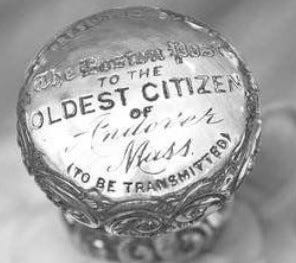


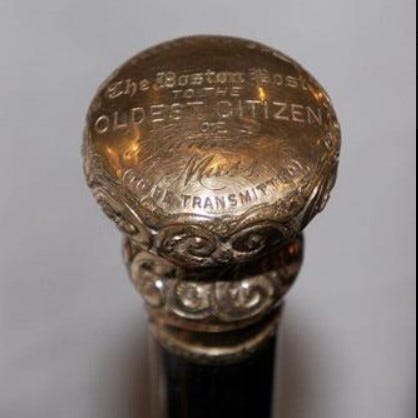

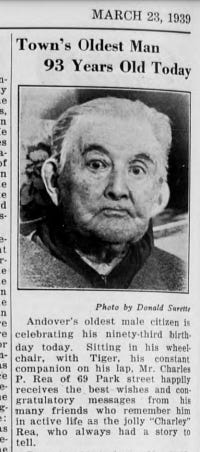
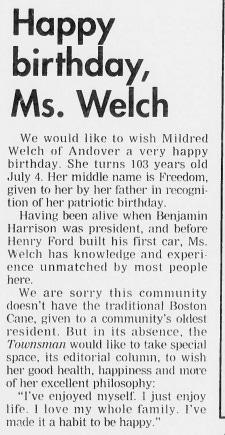
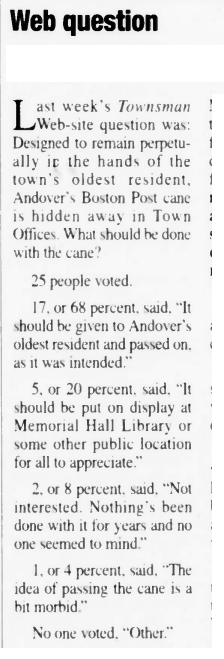
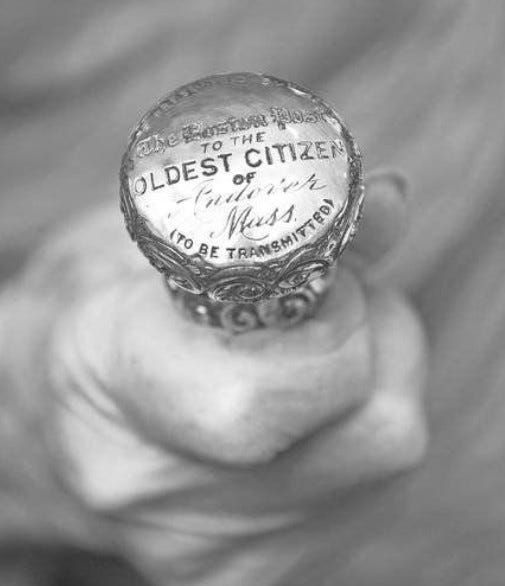
This is an interesting story. I am happy that the Boston post cane inspired other Andover traditions
I was just reading an article in The NY Times about these canes and wondered about updates for Andover’s cane. The pandemic interrupted so many things. Has the cane certificate been awarded recently? I do think the cane itself should stay in Town Hall or perhaps the library which is more visited. Virginia Begg